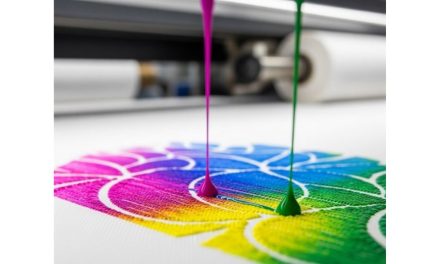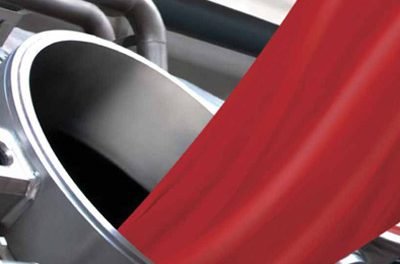 For the best output in Rotary Screen Printing, you need a good design and a good screen – but good pre-print equipment as well. But what determines how well your pre-printing equipment fits your process? And how to get the best results?
For the best output in Rotary Screen Printing, you need a good design and a good screen – but good pre-print equipment as well. But what determines how well your pre-printing equipment fits your process? And how to get the best results?
To print the best qualitative output, pre-printing might be just as important as the printing itself. With the right preprint equipment, you make sure your Rotary Screen is perfectly prepared for the job at hand. If the pre-printing doesn’t happen correctly, the design can come out wrong. In short, for the best output, you need a good design and a good screen – but good pre-print equipment as well.
That’s why we recently released our improved SmartLEX machines. The new machines, named ASPEN, features a 15% – 40% (6 beam machine) increased productivity compared to the previous model, ensuring pre-printing as precisely as possible and enabling the most accurate designs in Rotary Screen Printing. This blog highlights the essential aspects of pre-print equipment and how ASPEN provides you with the designs your customers’ dream of.
What are laser exposing and laser engraving for fabric printing?
There are two primary technologies for pre-printing and preparing your rotary screen. The first choice is Direct Laser Engraving, which is a single-step dry process. With this way of laser engraving for fabric printing, you simply engrave your coated screen with your desired design and print. This sustainable and simple process eliminates costly consumables like film or ink. No developing/washing process is necessary after engraving, making it less time-consuming, and no water is consumed. You’re ready to print in less than an hour.
The second technology for rotary screen engraving is laser exposing. Its lower initial investment is a reason many companies select this technology. It’s also known for its higher productivity. Unlike the dry laser engraving process, laser exposing is a wet procedure. This means that drying is required in this process. Still, it takes less than three hours to get ready to print. Although this takes longer than laser engraving, laser exposing has some advantages for your pre-print process.
Rotary Screen Engraving and Exposing: how to improve your Rotary Screens
 A few factors are important to keep in mind for the best and most efficient pre-print process. Pre-printing is the start of your printing process, and a good start is essential for qualitative output. This is the case for both rotary screen engraving and laser exposing.
A few factors are important to keep in mind for the best and most efficient pre-print process. Pre-printing is the start of your printing process, and a good start is essential for qualitative output. This is the case for both rotary screen engraving and laser exposing.
1. Productivity
As stated before, pre-printing is essential to the printing process, making sure your designs come out as desired. However, if the pre-printing process takes a long time, the entire printing process slows down. This is why productivity and efficiency are vital for pre-printing equipment.
Therefore, our experts have been working on machinery that provides precisely that productivity. The ASPEN is an excellent example of this. In essence, what’s required for heightened productivity is the faster moving of the exposing head back to the starting point. If the exposing head moves faster, the machine allows you to prepare more screens daily or in a certain amount of time. However, this should not affect the quality of the pre-printed screens.
The new machinery contains the best ratio of quality and quantity possible, allowing qualitative screens in a productive way. Of course, thanks to this efficiency, you can start printing sooner rather than later, making your entire printing process faster.
2. Resolution and Design Software
In a printing process, the desired outcome is the most important. Needless to say, the same applies to the pre-print process. As mentioned in the introduction, poorly performed pre-printing can impact your design. The resolution and design possibilities of pre-print equipment, like rotary screen engraving, are critical.
Especially for geometric and very detailed designs, the resolution is crucial. At SPGPrints, we think it is essential that the pre-print equipment cannot be the limiting factor for your design. That’s why our machines generally can work with 2032dpi, and the new ASPEN can even reach 2540dpi. This means that any design can be made with the highest quality level.
For halftones and other moiré-sensitive designs, the raster list of the machine is a deciding factor. This is carefully considered in the machines, but the design software used within the machines, BestIMAGE, also has features dedicated to reducing moiré. BestIMAGE enables easy and efficient textile design development.
3. Fitting of the Rotary Screen
Another crucial factor within the pre-print process is the fitting of the screen. Whether it is about laser exposing or laser engraving for textiles, the screen should be appropriately mounted in the machine, making it stable during the process. Otherwise, the design might be ruined.
Two features in the latest ASPEN machines make sure the fitting is perfect. The first one, inflate pressure, is present in every machine. It causes the screen to remain stable during the laser exposing process.
The second one is an optional “ring support system” feature, serving for perfect round screen mounting and resulting in even more stability. Especially for very long screens, this might prove invaluable. Another case where extra stability is very much needed is for multiple-colour designs. These colours should fit perfectly together, without any spaces in between. If any of the screens has been prepared unstable, there might be discrepancies, causing the design to show spaces between colours.
The ASPEN: trustworthy laser exposing for textile
The points mentioned above show how important the selection of pre-printing equipment is. The ASPEN was built to optimize the productivity, fitting and resolution of our pre-printing technology. This multi-beam laser exposing machine is exposing/hardening the non-image areas of your photosensitive coated rotary screen. The UV-laser system creates the image by direct exposure in a single step. Accuracy and high quality are crucial in this process.
As a result of low power input, no water cooling is necessary. At the same time, our experts prioritized ease of use. That’s why user-friendly, self-explanatory software is integrated in the machine. The status of your screen imaging process is continuously displayed on the monitor.
The perfect printing process for the best results
To get the best printing results, the entire (pre-) printing process is of the utmost importance. Printing machine, screens, design and pre-print equipment are all responsible for the output you deliver to your clients. So, what does your ideal (pre-) printing process look like?
Every application and business is different. Our Rotary Screen Printing experts love to discuss your unique challenges and opportunities with you in a One-on-One, so you can work towards the ideal printing process.
(By Albrecht Gebhard shares his knowledge about rotary textile printing. Thanks to his years of experience as a technical sales specialist, Albrecht can tell you all about textile printing, the latest innovations, and expectations for the future. In this article, he discussed about how to get the best pre-printing results for textile.)





















